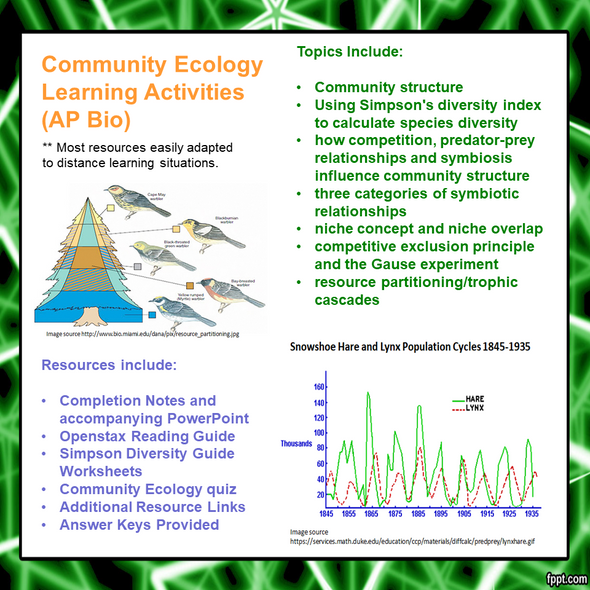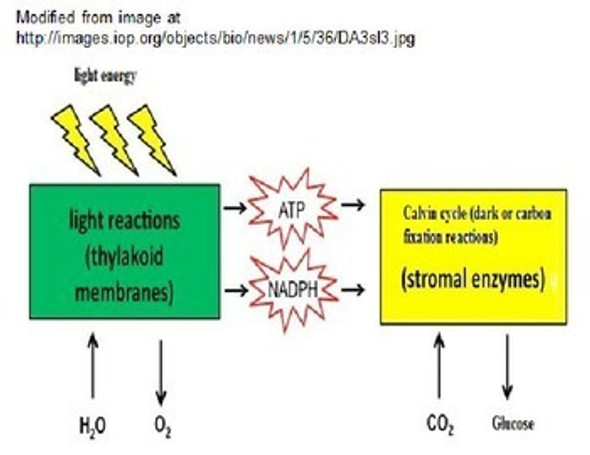Description
This zip file contains 22 different activities (72 different pages of student handouts) which can be used to compose a unit for biology students introducing them to basic concepts in ecology. The word documents and PowerPoint included may be easily modified to fit the needs of your course. These documents are well suited for use in distance learning environments.
Specifically the zip file contains the following items:
- Marzano self assessment scale for students specific to this unit
- Cloze completion notes handout for students with learning goals (13 pp.)
- PowerPoint (128 slides) to accompany the cloze completion notes (includes 5 bell ringers with key)
- Deer Population Graphing Worksheet with key
- Population Graphing Lab
- Ecology Worksheet 1 (Ecological organization and feeding terminology)with key
- Ecology Worksheet 2 (Symbiotic relationships) with key
- Ecology Worksheet 3 (Feeding Relationships -- chains, webs and pyramids) with key
- Ecology Worksheet 4 (Successions) with key
- Ecology Worksheet 5 (Biodiversity and Material Cycles) with key
- Three Ecology practice quizzes (may also be used as quizzes, homework or class work) with answers for students
- Ecology Unit Exam with key
Ecology Learning Goals
Upon the completion of this unit the student will:
1 define the term ecology.
2. define and list examples of populations, communities, and ecosystems.
3. define the term biosphere.
4. explain the difference between abiotic and biotic factors and explain why these must interact to produce a stable ecosystem..
5. list two requirements for a self-sustaining ecosystem.
6. list some reasons for competition between organisms.
7. define the term carrying capacity.
8. define and list examples of autotrophs and heterotrophs.
9. define the following terms pertaining to nutritional relationships and list examples of these; decomposer, herbivore, carnivore, omnivore, predator, and scavenger.
10. define and list examples for the terms parasitism, mutualism, and commensalism.
11. define and list examples of food chains and food webs.
12. explain what is meant by the following terms and correctly identify examples of these; producer, primary consumer, secondary consumer, and decomposer.
13. recognize that approximately 90% of the energy is lost between consecutive steps of a food web to heat and wastes and becomes unavailable for the next feeding level.
14. describe feeding interactions in the form of a food pyramid.
15. define the term biomass.
16. define the term succession.
17. explain how alterations in the environment may lead to successions.
18. define the terms pioneer organism and climax community.
19. list examples of pioneer organisms and climax communities.
20. recognize that succeeding successional stages make the environment becomes more unfavorable for itself and more favorable for succeeding successional stages.
21. describe in a paragraph a typical "New England old field" succession.
22. define the terms fauna and flora.
23. explain the competitive exclusion principle and list an example of this.
24. define the terms niche and habitat.
25. explain the role of photosynthesis and respiration in the carbon-oxygen cycle.
26. define the term biodiversity and explain how increased biodiversity leads to more ecosystem stability.
27. define the term monoculture and explain why it decreases biodiversity.
28. list and explain at least two reasons why increased biodiversity is valuable to humans.
NGSS Standards
Students who demonstrate understanding can:
HS-LS2-1. Use mathematical and/or computational representations to support explanations of factors that affect carrying capacity of ecosystems at different scales.
HS-LS2-2. Use mathematical representations to support and revise explanations based on evidence about factors affecting biodiversity and populations in ecosystems of different scales.
HS-LS2-4. Use mathematical representations to support claims for the cycling of matter and flow of energy among organisms in an ecosystem.
HS-LS2-5. Develop a model to illustrate the role of photosynthesis and cellular respiration in the cycling of carbon among the biosphere, atmosphere, hydrosphere, and geosphere.
HS-LS2-6. Evaluate the claims, evidence, and reasoning that the complex interactions in ecosystems maintain relatively consistent numbers and types of organisms in stable conditions, but changing conditions may result in a new ecosystem.
Common Core State Standards Connections:
ELA/Literacy
RST.11-12.1 Cite specific textual evidence to support analysis of science and technical texts, attending to important distinctions the author makes and to any gaps or inconsistencies in the account.
RST.11-12.8 Evaluate the hypotheses, data, analysis, and conclusions in a science or technical text, verifying the data when possible and corroborating or challenging conclusions with other sources of information.
WHST.9-12.2 Write informative/explanatory texts, including the narration of historical events, scientific procedures/ experiments, or technical processes.
Mathematics
MP.2 Reason abstractly and quantitatively.
MP.4 Model with mathematics.
HSN-Q.A.1 Use units as a way to understand problems and to guide the solution of multi-step problems; choose and interpret units consistently in formulas; choose and interpret the scale and the origin in graphs and data displays.
HSN-Q.A.2 Define appropriate quantities for the purpose of descriptive modeling.
HSN-Q.A.3 Choose a level of accuracy appropriate to limitations on measurement when reporting quantities.
HSS-ID.A.1 Represent data with plots on the real number line.
HSS-IC.A.1 Understand statistics as a process for making inferences about population parameters based on a random sample from that population.
NY Living Environment Core Curriculum
Performance Indicator 6.1
Explain factors that limit growth of individuals and populations.
Major Understandings
6.1a Energy flows through ecosystems in one direction, typically from the Sun, through photosynthetic organisms including green plants and algae, to herbivores to carnivores and decomposers.
6.1b The atoms and molecules on the Earth cycle among the living and nonliving components of the biosphere. For example, carbon dioxide and water molecules used in photosynthesis to form energy-rich organic compounds are returned to the environment when the energy in these compounds is eventually released by cells. Continual input of energy from sunlight keeps the process going. This concept may be illustrated with an energy pyramid.
6.1c The chemical elements, such as carbon, hydrogen, nitrogen, and oxygen, that make up the molecules of living things pass through food webs and are combined and recombined in different ways. At each link in a food web, some energy is stored in newly made structures but much is dissipated into the environment as heat.
6.1d The number of organisms any habitat can support (carrying capacity) is limited by the available energy, water, oxygen, and minerals, and by the ability of ecosystems to recycle the residue of dead organisms through the activities of bacteria and fungi.
6.1e In any particular environment, the growth and survival of organisms depend on the physical conditions including light intensity, temperature range, mineral availability, soil/rock type, and relative acidity (pH).
6.1f Living organisms have the capacity to produce populations of unlimited size, but environments and resources are finite. This has profound effects on the interactions among organisms.
6.1g Relationships between organisms may be negative, neutral, or positive. Some organisms may interact with one another in several ways. They may be in a producer/consumer, predator/prey, or parasite/host relationship; or one organism may cause disease in, scavenge, or decompose another.
Performance Indicator 6.2
Explain the importance of preserving diversity of species and habitats.
Major Understandings
6.2a As a result of evolutionary processes, there is a diversity of organisms and roles in ecosystems. This diversity of species increases the chance that at least some will survive in the face of large environmental changes. Biodiversity increases the stability of the ecosystem.
6.2b Biodiversity also ensures the availability of a rich variety of genetic material that may lead to future agricultural or medical discoveries with significant value to humankind. As diversity is lost, potential sources of these materials may be lost with it.
Performance Indicator 6.3
Explain how the living and nonliving environments change over time and respond to disturbances.
Major Understandings
6.3a The interrelationships and interdependencies of organisms affect the development of stable ecosystems.
6.3b Through ecological succession, all ecosystems progress through a sequence of changes during which one ecological community modifies the environment, making it more suitable for another community. These long-term gradual changes result in the community reaching a point of stability that can last for hundreds or thousands of years.
6.3c A stable ecosystem can be altered, either rapidly or slowly, through the activities of organisms (including humans), or through climatic changes or natural disasters. The altered ecosystem can usually recover through gradual changes back to a point of long term stability.
Appendix A -- Lab Skills
¥ Organizes data through the use of data tables and graphs
¥ Analyzes results from observations/expressed data
Bundle and Save!
Many more biology materials are available from Monday's Rescue. The Biology/Life Science Course contains 22 units which can be used to develop a full year course. A purchase of the Biology/Life Science Course provides significant savings of over 70% compared to purchasing each of the 22 units individually. This course is available for $24.99. It contains over 900 pages of learning materials and 1500 plus PowerPoint slides.
This year long course contains the following units:
- Life Processes and Introduction to Classification Learning Activities
- Cell Structure and Function Lesson Activities
- Membrane and Membrane Processes Learning Activities
- Introduction to Biochemistry and Enzymes Lesson Activities
- Human Nutrition Learning Activities
- Human Circulation Learning Activities
- Immunity Lesson and Lab Activities
- Human Respiration Learning Activities
- Introduction to Cell Respiration Learning Activities
- Introduction to Human Excretion and Human Locomotion Learning Activities
- Nervous and Endocrine Systems Lesson Activities
- Introduction to Mitosis and Asexual Reproduction Lesson Activities
- Introduction to Meiosis Lesson Activities
- Reproduction and Development Lesson Activities
- Plant Systems and Adaptations Lesson Activities
- Photosynthesis Learning Activities
- Plant Reproduction and Development Lesson Activities
- Classical Genetics Learning Activities (Mendelian and Beyond Mendel)
- Introduction to DNA, RNA, Protein Synthesis and Biotechnology Lesson Activities
- Introduction to Evolution Lesson Activities
- Ecology Lesson Activities
- Human Ecology Learning Activities
- Complete NY State Living Environment Regents Review Packets with Answers
View the contents of the whole year course in more detail at Biology/Life Sciences Complete Course
Terms of Use
Purchase of the product is for classroom use by the purchaser only. It is a violation for individuals, schools, and districts to redistribute or sell this item on the Internet or to other individuals. I do encourage you to use and edit these documents to suit your needs with your own students in distance learning environments.
This work is licensed under a Creative Commons Attribution-NonCommercial-ShareAlike 4.0 International License.
















